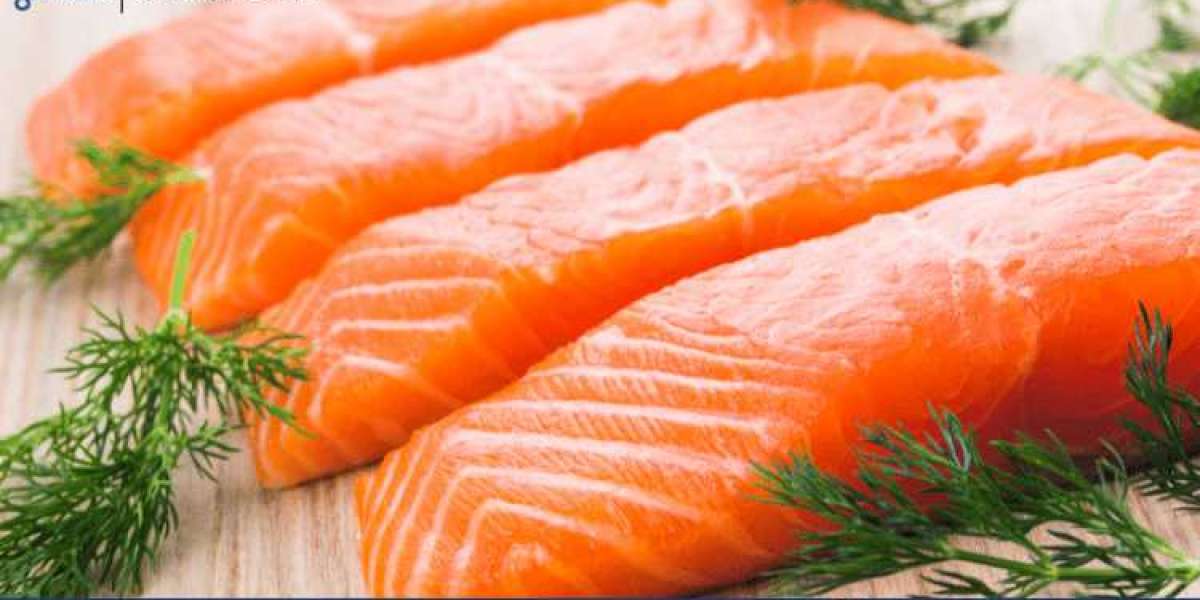Salmon Market Outlook
The global salmon market has shown remarkable growth, with its size reaching a volume of approximately 4.50 million tons in 2023. This growth trajectory is set to continue, with the market expected to expand at a compound annual growth rate (CAGR) of 3.8% between 2024 and 2032, ultimately reaching an estimated volume of about 6.33 million tons by 2032. This positive outlook is driven by several factors, including the rising awareness of the health benefits associated with salmon consumption, increasing consumer preference for protein-rich diets, and the growing popularity of salmon as a versatile ingredient in various cuisines.
Salmon is recognized for its high content of omega-3 fatty acids, proteins, and essential vitamins, making it a preferred choice among health-conscious consumers. This health trend has significantly boosted the demand for salmon globally, as more people seek nutritious and balanced diets. Additionally, the increasing prevalence of chronic diseases such as heart disease and diabetes has further propelled consumers toward healthier food options, including salmon, which is known for its heart-healthy properties.
Get a Free Sample Report with Table of Contents@ https://www.expertmarketresearch.com/reports/salmon-market/requestsample
The market is also witnessing a surge in demand due to the expanding aquaculture industry. Technological advancements and improved aquaculture practices have enhanced the efficiency and sustainability of salmon farming, leading to increased production to meet the growing demand. Countries like Norway, Chile, and Canada are prominent players in salmon farming, contributing significantly to the global supply. These nations have invested heavily in aquaculture infrastructure, ensuring a steady supply of high-quality salmon to global markets.
Moreover, the culinary versatility of salmon has made it a staple in many cuisines around the world. Its popularity spans various culinary traditions, from sushi and sashimi in Japanese cuisine to smoked salmon in European and North American dishes. The increasing trend of dining out and the rising number of seafood restaurants have further augmented the demand for salmon. Additionally, the convenience of ready-to-eat and processed salmon products has appealed to busy consumers, contributing to market growth.
E-commerce platforms have also played a crucial role in the market expansion. The convenience of online shopping and the availability of a wide range of salmon products on e-commerce platforms have made it easier for consumers to access and purchase salmon. This trend has been particularly significant during the COVID-19 pandemic, where lockdowns and social distancing measures have accelerated the shift towards online grocery shopping.
Read Full Report with Table of Contents@ https://www.expertmarketresearch.com/reports/salmon-market
However, the market faces challenges such as environmental concerns and the impact of climate change on salmon habitats. Sustainable farming practices and regulatory measures are essential to address these issues and ensure the long-term growth of the market. Innovations in aquaculture, such as land-based and recirculating aquaculture systems, are being explored to mitigate environmental impacts and enhance sustainability.
In conclusion, the global salmon market is poised for steady growth in the coming years, driven by health trends, advancements in aquaculture, culinary versatility, and the convenience of online shopping. With a projected CAGR of 3.8% from 2024 to 2032, the market is expected to reach a volume of about 6.33 million tons by 2032, reflecting the increasing global appetite for this nutritious and versatile seafood.
Salmon Market Segmentation
On the basis of type, the global salmon market can be divided into:
- Farmed
- Wild Captured
The species of salmon can be segmented into:
- Atlantic
- Pink
- Chum/Dog
- Coho
- Sockeye
- Others
The end product type can be categorised as follows:
- Frozen
- Fresh
- Canned
- Others
The distribution channels can be segmented into the following:
- Foodservice
- Retail
- Others
The farmed variant is majorly produced in the following regions:
- Norway
- Chile
- Scotland
- Canada
- Faroe Islands
- Others
The wild captured variant are majorly found in the following regions:
- United States
- Russia
- Japan
- Canada
- Others
The major consuming regions of the product include the following:
- European Union
- Russia
- United States
- Brazil
- Japan
- China
- Others
Challenges in the Salmon Market
- Environmental Concerns: The salmon farming industry faces criticism for its environmental impact, including water pollution, habitat destruction, and the spread of diseases to wild salmon populations.
- Solution: Implement sustainable farming practices, such as integrated multi-trophic aquaculture (IMTA) and closed containment systems, to minimize environmental impact.
- Disease and Parasites: Farmed salmon are susceptible to diseases and parasites, such as sea lice, which can lead to significant stock losses.
- Solution: Use innovative technologies like cleaner fish (e.g., wrasse) that eat parasites, and develop vaccines and more effective disease management protocols.
- Market Saturation and Competition: The salmon market is highly competitive, with major producers like Norway, Chile, and Canada dominating the market. This can lead to price volatility and pressure on smaller producers.
- Solution: Differentiate products through quality, certifications (e.g., organic, non-GMO), and value-added products (e.g., smoked salmon, ready-to-eat meals).
- Regulatory Hurdles: Navigating the complex regulatory landscape across different countries can be challenging for salmon producers.
- Solution: Stay informed about regulatory changes, invest in compliance, and engage with policymakers to shape favorable regulations.
- Sustainability and Ethical Concerns: Increasing consumer awareness about sustainability and ethical practices in food production puts pressure on salmon producers to adopt more responsible practices.
- Solution: Obtain sustainability certifications (e.g., ASC, MSC) and communicate these efforts transparently to consumers to build trust and brand loyalty.
Opportunities in the Salmon Market
- Growing Demand for Healthy Protein Sources: As consumers become more health-conscious, the demand for salmon, a rich source of omega-3 fatty acids and high-quality protein, continues to rise.
- Strategy: Capitalize on this trend by marketing the health benefits of salmon and developing new product lines catering to health-focused consumers.
- Innovation in Aquaculture Technology: Advances in technology, such as automated feeding systems, underwater drones, and AI-driven monitoring, can improve efficiency and reduce costs.
- Strategy: Invest in the latest aquaculture technologies to optimize operations, reduce environmental impact, and improve fish welfare.
- Expansion into Emerging Markets: Emerging economies, particularly in Asia, are showing increased demand for high-quality seafood, including salmon.
- Strategy: Explore and invest in emerging markets, adapt products to local tastes, and establish strong distribution networks to capture market share.
- Development of Value-Added Products: There is a growing market for value-added salmon products such as smoked salmon, salmon jerky, and ready-to-eat meals.
- Strategy: Innovate and diversify product offerings to include convenient, ready-to-eat, and premium products that cater to diverse consumer preferences.
- Sustainable and Ethical Branding: Brands that emphasize sustainability and ethical practices can differentiate themselves in a crowded market.
- Strategy: Focus on sustainability initiatives, obtain relevant certifications, and actively promote these values in marketing campaigns to attract eco-conscious consumers.
Methods to Deal with Challenges and Opportunities
- Adopting Sustainable Practices: Implement eco-friendly farming techniques, reduce waste, and use renewable energy sources to mitigate environmental impact and appeal to environmentally conscious consumers.
- Leveraging Technology: Utilize advanced technologies for disease management, efficient feeding, and monitoring to enhance productivity and reduce operational costs.
- Product Diversification: Develop a range of value-added products to cater to different consumer segments and reduce dependence on raw fish sales.
- Market Research and Adaptation: Conduct thorough market research to understand consumer preferences in different regions and adapt products and marketing strategies accordingly.
- Strategic Partnerships and Alliances: Form partnerships with technology providers, regulatory bodies, and sustainability organizations to stay ahead of industry trends and ensure compliance with standards.
- Transparent Communication: Maintain transparency with consumers regarding farming practices, sustainability efforts, and product sourcing to build trust and loyalty.
Read More Trending Reports:
Global Coco Coir Market: https://www.expertmarketresearch.com/reports/coco-coir-market
Global Waste Sorting Equipment Market: https://www.expertmarketresearch.com/reports/waste-sorting-equipment-market
Global Magnetic Plastics Market: https://www.expertmarketresearch.com/reports/magnetic-plastics-market
Media Contact:
Company Name: Claight Corporation
Contact Person: Olivia Brown, Corporate Sales Specialist – U.S.A.
Email: sales@expertmarketresearch.com
Toll Free Number: +1-415-325-5166 | +44-702-402-5790
Address: 30 North Gould Street, Sheridan, WY 82801, USA
Website: www.expertmarketresearch.com
Aus Site: https://www.expertmarketresearch.com.au/








